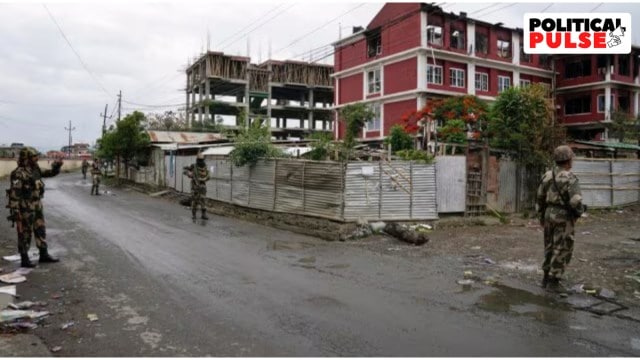PM talks of 10 times Manipur has been under President’s rule. A look at why and when
The most times were during the late ’60s and ’70s, the last time was in 2001
 Since 2001, Manipur has not seen a stint of President’s rule. AP/File photo
Since 2001, Manipur has not seen a stint of President’s rule. AP/File photoIn his reply to the debate on the Motion of Thanks on the President’s address, Prime Minister Narendra Modi spoke of the continuing Manipur conflict and said the BJP “has been making every effort to restore peace in the strife-torn Northeastern state”.
Noting that Manipur has had a “long history” of “social struggle”, the PM added: “Congress people should not forget that because of these reasons, President’s rule had to be imposed 10 times… There have to be some issues. And this has not happened in our tenure.”
Of the 10 times when President’s rule, or Article 356, has been invoked in Manipur, six were in the late 1960s and the 1970s, when the country was seeing a rise of political parties opposed to the Congress, and when there was political instability in Manipur. After a peaceful stint in the 1980s, Central rule returned, with the state remaining under Article 356 for nearly a year in the wake of bloody ethnic clashes.
Since 2001, Manipur has not seen a stint of President’s rule. However, since the Meitei vs Kuki tribal conflict began in the state 14 months ago, an officer deputed by the Centre has been the “security advisor” to the N Biren Singh-led BJP government, and was acknowledged by Union Home Minister Amit Shah as the chief of a Unified Command coordinating efforts of all security forces in an “unbiased” way.
October 25, 1967: The first time Article 356 was invoked in Manipur was against the backdrop of demands for a separate state. A Lok Sabha handbook on President’s rule notes that the Assembly had 32 seats. Longjam Thambou Singh of the United Front was the Chief Minister. A Member of the United Front moved to the Congress Party. This was followed by subsequent resignations of the Speaker and Deputy Speaker from their offices. After this, both the parties failed to reach a consensus on nominating a candidate for the post of the Speaker and President’s rule was imposed.
October 16, 1969: A motion of no-confidence was passed by the Assembly in September that year because of MLAs hopping parties. Chief Minister M Koireng Singh of the Congress resigned and no party was in a position to form a stable government.
January 21, 1972: The North Eastern Areas (Reorganization) Act, 1971, paved the way for the formation of a new state of Manipur on January 21, 1971. The new state was under President’s rule until elections were held to the Legislative Assembly.
March 28, 1973: Mohammad Alimuddin of the United Legislature Party was the Chief Minister then, but due to factionalism and groups within the party, a motion of no-confidence was moved, and he could not claim his majority. “The Governor at the time did not invite the Opposition, which had a claim to a tenuous majority, because the budget had to be passed before March 31, 1973. Therefore, President’s rule was proclaimed,” the Sarkaria Commission of 1983 on Centre-State relations had said.
May 16, 1977: The Congress(I)’s R K Dorendra Singh was the CM, heading a coalition ministry. In May of that year, due to defections of his MLAs to the Janata Party, Singh lost support. No other party was prepared to form a government.
November 14, 1979: The Janata Party’s Yangmasha Shaiza was in power, but the Governor sent a report saying the government was “corrupt, devoid of integrity and unprincipled”. Consequently, the Assembly was dissolved.
February 28, 1981: A Congress(I) government headed by Rishang Keishing was in office. Resignation of 10 Members from the party reduced the ruling party to a minority. According to the Governor’s assessment, no party was in a position to form a stable ministry.
January 7, 1992: A United Legislature Front government under R K Ranbir Singh was leading a coalition government at the time. His ministry lost its majority after the resignation of Janata Dal Legislators from the party.
December 31, 1993: R K Dorendra Singh of the Congress headed the government that followed. This time, President’s rule was imposed in the wake of bloody Naga-Kuki clashes, resulting in about 1,000 deaths. The longest period of Central rule in the state followed after this, lasting 346 days until December 13, 1994, when Rishang Keishing of the Congress was sworn in.
June 2, 2001: Radhabinod Marwah Koijam of the People’s Front was in power then. A revolt by 34 legislators reduced his government to a minority. At a special session of the Assembly, a motion of confidence was defeated. Other political parties could not form an alternative government. Subsequently, elections to the state Assembly were held in February 2002. The Congress’s Ibobi Singh took oath as the CM in March 2002.
- 01
- 02
- 03
- 04
- 05































